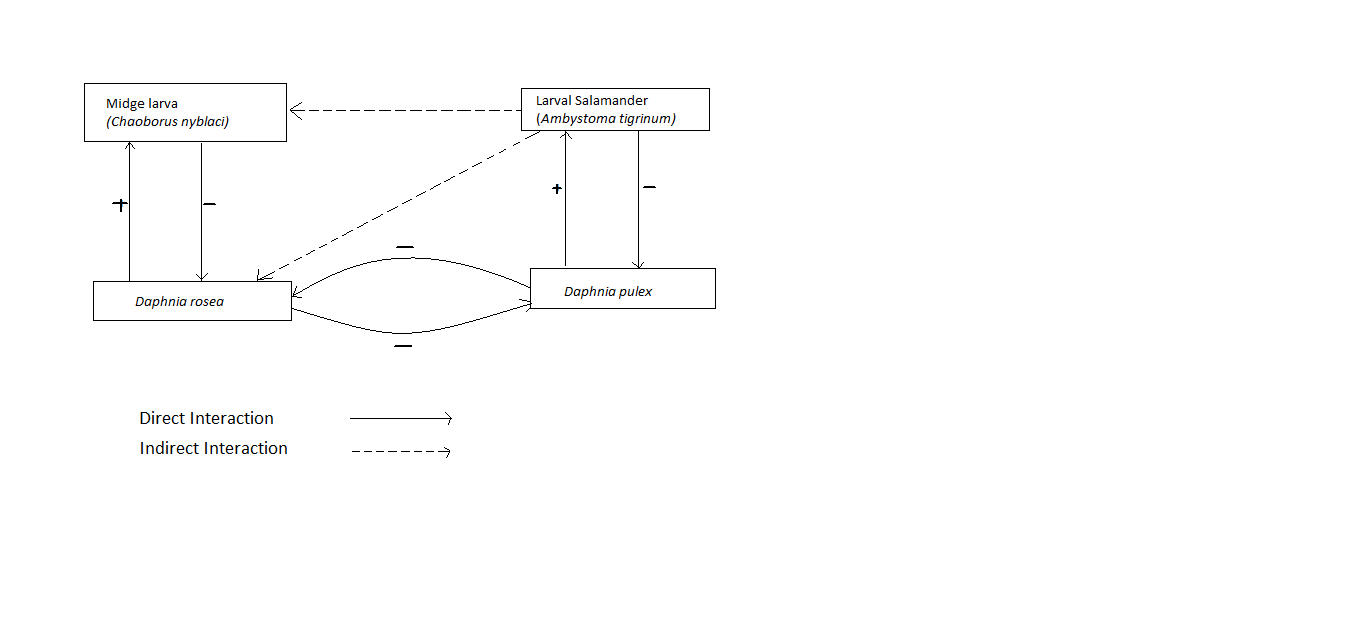
Answer
451.2k+ views
Hint:The animal world depicts different types of relationships in the form of interactions. Ecological interdependence is reflected in their interactions, mainly for food, space, reproduction, and protection. These can have direct effects or indirect effects that means they can have positive and negative effects.
Complete step by step answer:The above question is based on the concept of ecological interdependence.
The effects of interactions are broadly categorized as direct (directly from one individual to another) and indirect effects (mediated through a transmitter).
Interactions have direct effects between populations of species in a community and are broadly categorized into positive, negative, or neutral interactions, depending upon the nature of the effect of the interacting organism.
In neutral interaction, interacting species have no effect on each other.
The interaction in which both participating species are benefitted is called positive interaction.
The interacting species in which one or both participating species get harmed is called a negative interaction.
As indicated by the picture, the presence of high quantities of larval lizards will restrain the Daphnia pulex creation or formation. This will show constructive outcomes on D. rosea on the grounds that D. pulex has a negative impact on it. At the point when larval lizards are available, predation lessens the populace development pace of the bigger Daphnia, D. pulex. This will encourage the concurrence of the Daphnia rosea. The two types of Daphnia for similar assets and henceforth increment in asset accessibility will build the number of midge hatchlings and larval lizards as the two types of Daphnia have beneficial outcomes. Expansion in the quantity of D. pulex would prompt a lessening in the quantity of D. rosea. This ultimately will diminish the number of midge hatchlings.
Consequently, the choices (A) Presence of high numbers of larval Salamander have an indirect effect on D. rosea and it is a positive effect.
(B) When larval salamanders are present, predation reduces the population growth rate of the larger Daphnia, facilitating the coexistence of the two species of Daphnia.
and (D) Increase in the number of D. pulex would lead to a decrease in the number of midge larvae is right.
So, (A), (B), and (D) are correct choices.
Note:The effects of interaction between a community can be direct effects or indirect effects. The receiver and donor are both affected differently according to the extent of effects. The transmitter is an important second species that plays a major role in indirect transmission. Direct interactions further lead to positive interactions (facilitation), negative interaction, and neutral interaction (neutralism).
Complete step by step answer:The above question is based on the concept of ecological interdependence.
The effects of interactions are broadly categorized as direct (directly from one individual to another) and indirect effects (mediated through a transmitter).
Interactions have direct effects between populations of species in a community and are broadly categorized into positive, negative, or neutral interactions, depending upon the nature of the effect of the interacting organism.
In neutral interaction, interacting species have no effect on each other.
The interaction in which both participating species are benefitted is called positive interaction.
The interacting species in which one or both participating species get harmed is called a negative interaction.
As indicated by the picture, the presence of high quantities of larval lizards will restrain the Daphnia pulex creation or formation. This will show constructive outcomes on D. rosea on the grounds that D. pulex has a negative impact on it. At the point when larval lizards are available, predation lessens the populace development pace of the bigger Daphnia, D. pulex. This will encourage the concurrence of the Daphnia rosea. The two types of Daphnia for similar assets and henceforth increment in asset accessibility will build the number of midge hatchlings and larval lizards as the two types of Daphnia have beneficial outcomes. Expansion in the quantity of D. pulex would prompt a lessening in the quantity of D. rosea. This ultimately will diminish the number of midge hatchlings.
Consequently, the choices (A) Presence of high numbers of larval Salamander have an indirect effect on D. rosea and it is a positive effect.
(B) When larval salamanders are present, predation reduces the population growth rate of the larger Daphnia, facilitating the coexistence of the two species of Daphnia.
and (D) Increase in the number of D. pulex would lead to a decrease in the number of midge larvae is right.
So, (A), (B), and (D) are correct choices.
Note:The effects of interaction between a community can be direct effects or indirect effects. The receiver and donor are both affected differently according to the extent of effects. The transmitter is an important second species that plays a major role in indirect transmission. Direct interactions further lead to positive interactions (facilitation), negative interaction, and neutral interaction (neutralism).
Recently Updated Pages
Fill in the blanks with suitable prepositions Break class 10 english CBSE

Fill in the blanks with suitable articles Tribune is class 10 english CBSE

Rearrange the following words and phrases to form a class 10 english CBSE

Select the opposite of the given word Permit aGive class 10 english CBSE

Fill in the blank with the most appropriate option class 10 english CBSE

Some places have oneline notices Which option is a class 10 english CBSE

Trending doubts
Fill the blanks with the suitable prepositions 1 The class 9 english CBSE

How do you graph the function fx 4x class 9 maths CBSE

When was Karauli Praja Mandal established 11934 21936 class 10 social science CBSE

Which are the Top 10 Largest Countries of the World?

What is the definite integral of zero a constant b class 12 maths CBSE

Why is steel more elastic than rubber class 11 physics CBSE

Distinguish between the following Ferrous and nonferrous class 9 social science CBSE

The Equation xxx + 2 is Satisfied when x is Equal to Class 10 Maths

Differentiate between homogeneous and heterogeneous class 12 chemistry CBSE





